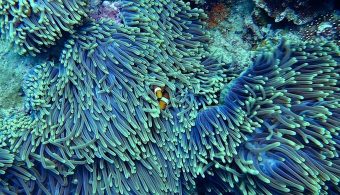
Coral reefs are home to a vast array of ocean creatures. They provide food, protection against storm damage, sustain tourism and inspire wonder. “If we lose corals, we lose a vital piece of our planet,” said Kiho Kim.
Kim, a professor in the department of environmental sciences at American University, has been studying the fate of corals in our warming and increasingly polluted world — and he’s worried about what he’s found.
Recently, he and his colleagues examined the effects of nitrogen from sewage plants and septic tanks on coral skeletons in Guam, a U.S. territory that has undergone dramatic ecological changes over the last 60 years. Their research appears in the journal Marine Pollution Bulletin.
The diverse ecosystems that comprise coral reefs are suffering worldwide as a result of climate change, overfishing and pollution. Recently, scientists found warmer waters killed whole sections of Australia’s Great Barrier Reef.
Kim is concerned, but he also is optimistic, believing the much of the damage seen thus far is reversible. “We definitely see signs of pollution stress,” he said. But, “in general, reefs are resilient and can come back if the stressor is removed.”
His study didn’t look at the effects of ocean acidification, a result of carbon pollution. However, “acidification and warming exacerbate the impact of pollution,” he said, adding: “If we can clean up our coastal waters, perhaps the corals and other creatures can better adapt to climate change.”
He also notes that in areas where reefs lie near human settlements, “pollution probably plays a more important role than acidification in how healthy a reef is because changes in pollution levels have been so much greater,” he said.
When coral grow, they put down layers of skeleton, a process Kim likens to erecting an apartment building. “It starts with a single room, a single coral polyp which looks like a tiny anemone, that divides and builds another room occupied by a genetically identical coral polyp derived from the first one,” he explained.
“This allows the coral to grow horizontally,” he continues. “In addition, the coral grows vertically by adding additional floors. In the case of corals, only the top floor is occupied by the coral polyps. So when you take a core, you can see annual growth layers, or ‘floors.’ You actually have to take an x-ray of the core after you split it because the layers are not obvious to the naked eye.”
The team worked with coral on the eastern side of Guam, in the Togcha River watershed, where a community sewage plant dumps waste that flows downstream to the reefs. Kim and his colleagues extracted a single skeleton from a colony of massive coral near the mouth of the river, in water about 20 feet deep. They used a high pressure air drill attached to a scuba tank to remove a core more than two feet long.
They then capped the hole with a cement plug. Upon examining it later, they found coral tissue growing over the plug, indicating the coral was still healthy.
The researchers then measured the ratio of nitrogen isotopes in the coral. In the case of nitrogen, there are two isotopes: 15N and 14N, the numbers referring to the number of neutrons in the nucleus. Scientists measured the relative abundance of 15N and 14N isotopes in a biological sample by detecting the different weights of the two isotopes.
“For our study, we focused on nitrogen, which is commonly used in pollution studies because different sources of nitrogen have distinct ratios of heavy nitrogen (15N) to light nitrogen (14N),” he explains.
“Fertilizer, for example, has a low ratio of heavy nitrogen to light nitrogen,” he adds. “Sewage, on the other hand, has a higher ratio of heavy nitrogen to light nitrogen. By analyzing the ratio of heavy to light nitrogen in the biological material, we can figure out where most of the nitrogen came from. Often, it’s either fertilizer or sewage, the two common sources of nitrogen in coastal environments.”
In this case, not surprisingly, the damage came from sewage-derived nitrogen.
The scientists used a new method — a chemical technique developed by Princeton University scientist and study co-author Xingchen Wang — to extract the nitrogen from the coral skeletons for isotope analysis. The new process requires much less coral skeletal material, thus conserving more of the skeleton.
“The new method is able to analyze the actual skeleton rather than tissue remnants left in the skeleton,” he said. “Tissue remnants are not abundant, which means that the conventional method requires sampling a lot of skeleton in order to get enough tissue for the isotope analysis. With our new method, much less skeleton is required for sampling.”
The nitrogen pollution recorded by the researchers correlated with Guam’s population increases over the past 60 years. Between 1960 and 1980 alone, the population of the Togcha watershed grew tenfold.
The people of Guam “can do something about pollution,” Kim said. “Technology is available to remove nutrients like nitrogen from sewage, although it’s very expensive… But we have to weigh the costs of upgrading treatment plants against the costs of losing the reefs and the ecosystem. With the proper accounting, the math generally favors paying to protect the coral reefs and other coastal ecosystems.”
Source: cleantechnica.com



